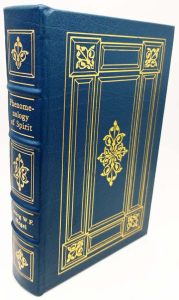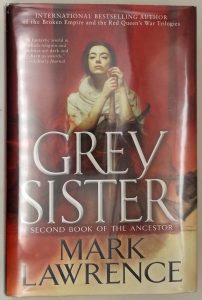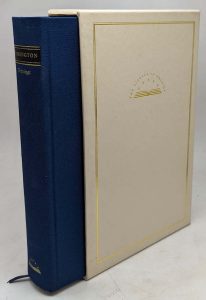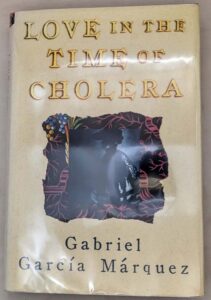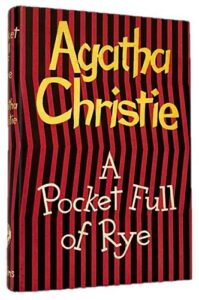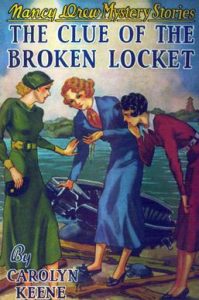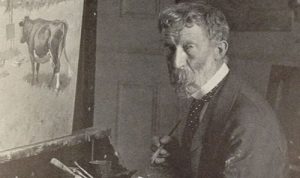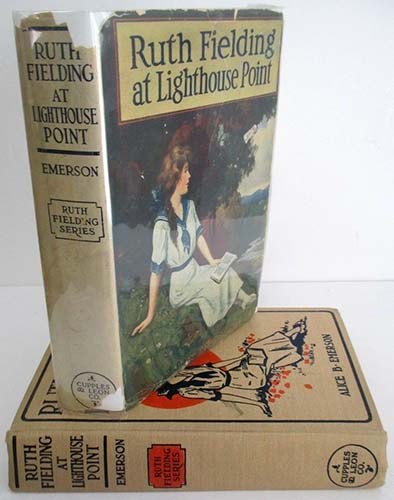
During the early years of the 20th century, the most popular girls’ series was Ruth Fielding by Alice B. Emerson, which lasted from 1913 to 1934 and included thirty books. This is the series that was the inspiration for all the others included in this book.
Ruth Fielding was the creation of Edward Stratemeyer. Stratemeyer developed the plot outlines for the books and assigned them to “ghost writers” who filled in the details. W. Bert Foster wrote some of the Ruth Fielding books as “Alice B. Emerson.” Lilian Garis, who wrote many of her own books such as the Melody Lane Series, probably had a hand in several of them. The most famous writer who worked from Stratemeyer’s. Ruth Fielding outlines was Mildred A. Wirt Benson who did volumes 23 though 26 before she concentrated on the new Nancy Drew Series. The Ruth Fielding books were written during the high point in the development of new girls’ series. (Carol Billman reports in The Secret of the Stratemeyer Syndicate that from 1910 to 1920 there were about ninety-four different girls’ series books in progress.)
Ruth began as a poor orphan, a staple of 19th century girls’ books. With the “luck and pluck” of an Alger hero, she took on the most popular roles of women in the early 20th century. Ruth became internationally famous as a detective, a scenario writer for the movies, a leading actress, a director and a film company owner. Like many other modern heroines of her time, she attended boarding school and college where she earned many good friends. She also became a wife and mother without giving up her career. No doubt much of the inspiration for this came from Mary Pickford (1893-1979) who was the most famous woman in the world during the same time period as the Ruth Fielding books were written. “Little Mary,” who was the number one film box office attraction for twenty-four years, did all that Ruth did, except that she was not involved in solving mysteries.
One thing that sets Ruth apart from other girl sleuths and series heroines is that she worked hard to accomplish her goals and did not have a loving parent or unlimited funds to help her. In 1927, the year that aviator Charles Lindbergh crossed the Atlantic in The Spirit of St. Louis, Ruth won $50,000 in a movie scenario contest, twice the amount of the Orteig Prize that Lindbergh got for being the first to fly non-stop from New York to Paris.
Probably the reason why the Ruth Fielding Series ended is that as Ruth continued to age, her appeal was lost to her readers. Nancy Drew, who was “born” at the time the Ruth Fielding Series was ending, was never plagued with the problem of aging or changing and she has lasted for more than seventy years now.
The Ruth Fielding Series of thirty books never had to endure the indignity of being “updated and modernized,” although the books are now far less well-known than Ruth’s successors, as her appeal and the situations in which she was involved go back too many generations. It does seem to be a fact of fictional life that a girl detective loses her popularity if her mysteries have a dated quality to them. It is still possible for youngsters to worry about conducting a search for a will that will aid an unfortunate person but it is difficult for them to identify with hunting for a “fest soldier.. .at the War Front” or dealing with the creation of “Taikina Pictures,” let alone becoming involved with the internal politics of the “monarchies of Estralia and Bellogia.”
Ruth Fielding Illustrators
There are only four different dust jacket designs for the thirty Ruth Fielding books, but several different illustrators did the frontispieces inside the books, including W.S. Rogers, R. Emmett Owen, Thelma Gooch, Bess Goe Willis and Russell H. Tandy.
Russell H. Tandy (1893-1961) painted dust jackets for many juvenile series books from 1929 to 1949. For Cuppies & Leon, he did the Peggy Lee Stories for Girls, the Buddy Series by Howard R. Garis and the frontispieces for the last three Ruth Fielding books. For Grosset & Dunlap, he painted the dust jackets and the internals for the first twenty-six Nancy Drew books (except for the dust jacket on Volume 11) and many dust jackets and frontispieces for Beverly Gray and Hardy Boys books. His color work is noted for the strong primary colors of his palette and the absence of weak pastel shading. His signature is always prominently featured on his artwork.
Clara M. Burd (1873-1933) did the “Wall” dust jacket of the Ruth Fielding series. She is probably the most important 20th century illustrator whose paintings appear on series books. Much of her work is signed “CMB” or “C.M. Burd,” which has often confused her with English illustrator Cicely Mary Barker. Burd’s beautiful watercolors have a strong three-dimensional effect because of the manner in which she outlined her figures. Among her many book illustrations are the ones done for the John C. Winston Company’s Louisa May Alcott books and for other classics, such as Heidi and Hans Brinker. The poignant children in several versions of Robert Louis Stevenson’s A Child’s Garden of Verses for Saalfield from the 1920s through the 1940s, are among her best work. She also did a huge quantity of religious paintings that were used for Sunday School diplomas and post cards, most of them featuring small children. The people in Burd’s work appear to be from the 19th century, which is the reason I like them so much. For the first third of the 20th century her work was featured on every conceivable type of item that required illustrations, from bread wrappers to popular magazine covers, and she also did stained glass designs for Tiffany’s.
Ruth Fielding Books
All the Ruth Fielding books were published by Cuppies & Leon in “thick” editions with a spine of about 1 1/4 inches wide. They all have good cloth covers, thick pages and a glossy frontispiece. These frontispiece pictures were printed on glossy paper so the reproduction quality would be better than if they were done on the paper of the text pages and they were hand-inserted into the books. Many series books of the 1930s included up to four of these pictures in them. And, at this time, the books cost 50 cents each, which was a bargain even then.
There are two distinct types of hard tan covers on the Ruth Fielding books. The first is an early 20th century scene of Ruth sitting beside a creek bank and holding an open book. She is wearing a long “sailor-type” dress. The second cover is from 1929 and it shows the same scene in an updated version in which Ruth wears a short- skirted dress. The earlier picture has red highlights in it; the second version does not.
There are four different dust jacket designs on the Ruth Fielding books and all of them are alike for the set that they represent, except that the title is changed for the proper volume in the series. The four dust jacket designs became progressively more sophisticated as they were updated.
Jacket #1, “Plain creek bank.” This is the same scene as the hard cover of 1913 to 1929. The paper stock is heavier than any later covers.
Jacket #2, “Color creek bank.” For the second set of dust jackets, the first one was redrawn and painted in color with a full background showing the creek bank more clearly. In many ways, the revised pose of Ruth is stiffer looking than the plainer picture, which can be noted in the awkward way in which she holds her book. Ruth Fielding expert Kenneth Hopping places this jacket as beginning in 1918.
Jacket #3,“Wall.” Ruth is standing in front of a high stone wall and wearing a long red cape. The costume that she wears in this Clara M. Burd illustration from 1926 seems even more old-fashioned than the early “creek bank” dresses, but I like it best because Ruth seems so young and innocent and I am a great fan of Clara M. Burd art.
Jacket #4, “Collage.” The 1929 dust jacket shows a portrait of Ruth with short, bobbed hair surrounded by eight scenes from her life, including a hand-cranked motion picture camera photographing her. This dust jacket is colorfill and interesting and it must have looked very modem in 1929. I wish that we knew who painted it.
Dust Jacket Style #4 is the only one in which an entire set of Ruth Fielding books potentially could be collected in a uniform format. It was not unusual at the time of the Ruth Fielding books to present an entire series with a single dust jacket picture. The Buddy Series from Cuppies & Leon was done this way and the Bobbsey Twins books from Grosset & Dunlap had the same picture on each dust jacket in the set for years, although they were updated many times like the Ruth Fielding dust jackets.
Most of the Ruth Fielding books have secondary titles that help to explain more about the theme or plot of the book. This was a common manner of titling mystery and series books in the early years of the 20th century. Only the main title appears on the covers and dust jackets of the books. The “subtitle” is listed on the title page and on some lists inside the books and on some of the flaps of the dust jackets. An example of this is: Ruth Fielding at Silver Ranch Or Schoolgirls Among the Cowboys. (There are variations of punctuation and capitalization in dealing with the “Or.”)
Ruth Fielding Book Formats (First Edition Identification Guide)
I. 1913-1918
- Thick tan cover w/1913 scene
- The DJ repeats the hard cover picture
- Explain creek bank” DJGlossy frontis
- Good paper
II. 1918-1925
- Same tan cover as Format I
- Full color, full scene DJ “Color creek bank” DJ Glossy frontis
- Good paper
III. 1926- 1928
- Same tan cover as Format I
- “Wall” DJ
- Glossy frontis
- Good paper
IV. 1929- 1934
- Thick tan cover w/1920s scene
- “Collage” DJ
- Glossy frontis
- Good paper
Ruth Fielding Book List
- Ruth Fielding of the Red Mill (1913)
- Ruth Fielding at Briarwood Hall (1913)
- Ruth Fielding at Snow Camp (1913)
- Ruth Fielding at Lighthouse Point (1913)
- Ruth Fielding at Silver Ranch (1913)
- Ruth Fielding at Sunrise Farm (1915)
- Ruth Fielding and the Gypsies (1916)
- Ruth Fielding in Moving Pictures (1916)
- Ruth Fielding Down in Dixie (1916)
- Ruth Fielding at College (1917)
- Ruth Fielding in the Saddle (1917)
- Ruth Fielding in the Red Cross (1918)
- Ruth Fielding at the War Front (1918)
- Ruth Fielding Homeward Bound (1919)
- Ruth Fielding Down East (1920)
- Ruth Fielding in the Great Northwest (1921)
- Ruth Fielding on the St. Lawrence (1922)
- Ruth Fielding Treasure Hunting (1923)
- Ruth Fielding in the Far North (1924)
- Ruth Fielding at Golden Pass (1925)
- Ruth Fielding in Alaska (1926)
- Ruth Fielding and Her Great Scenario (1927)
- Ruth Fielding at Cameron Hall (1928)
- Ruth Fielding Clearing Her Name (1929)
- Ruth Fielding in Talking Pictures (1930)
- Ruth Fielding and Baby June (1931)
- Ruth Fielding and Her Double (1932)
- Ruth Fielding and Her Greatest Triumph (1933)
- Ruth Fielding and Her Crowing Victory (1934)
Source: All About Collecting Girls’ Series Books. John Axe, 2002.
